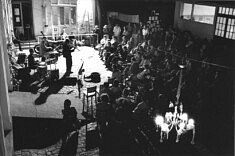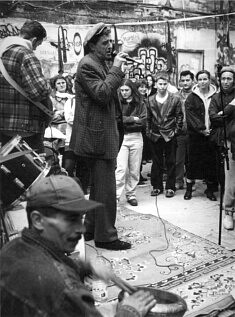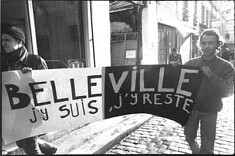Our Story
Created in March 1989, the artist collective “Ateliers d’Artistes de Belleville” (meaning Artists’ Studios of Belleville) was founded when a number of visual artists came together and decided to carve a spot for themselves in the urban landscape, all while preserving their creative spaces. This is our story…

Ramponeau courtyard during Belleville Artists’ Open Studios, 5th edition (Photo Yves Breton, 1994)
BELLEVILLE, HOMELAND FOR ARTISTS
During the late 1970s, Belleville is a Parisian working-class district of contrasting settings, ranging from old, half-demolished buildings and vacant lots to multiple urban renovation projects: a spectacle captured in photos by
François-Xavier Bouchart or Henri Guérard for exemple.
A first wave of artists, mainly Parisians, land in Belleville during those years to set up camp in the district. They occupy old artisanal and industrial buildings and begin to transform them into their own creative studios—their ateliers—allowing them to further invest themselves in the life of the neighbourhood, and gather into various collectives.
THE OPEN Studios, A NEW MEETING PLACE

Open Studios, 1997 (Ph. JP Connan)
In January 1990, three sculptors, Miki Tica; Christian Guillemin, and Éric Théret gather in the Éric’s atelier at 48 Rue Ramponeau (20e) to contemplate creating a collective of artists, with a vision of opening their ateliers to the public.
In his words: “Me and Christian had come to the same conclusion: many ateliers were in danger of disappearing, and we, young 31-year-old artists, had shown only very little of our work despite wanting to see the public’s reaction to it.” – Éric Théret (first secretary of the collective)
In May 1990, the first edition of the “Belleville Artists’ Open Studios” is held. The goal of the event is to defend the artists’ creative spaces from eviction, open them up to the public, and create bridges between different cultural expressions. It is met with immediate success: the publics support is fervent and the media coverage extensive. The “Open-Doors” become an annual gathering in Belleville, as well as a model event that will be further exported into France and the rest of the world. It is also the visible manifestation of a rising network of artists coming together.
PRESERvation OF CREATIVE SPaces and OF A PATRIMONY
From 1989, the municipality undertakes a policy of urban renewal that projected almost the entire destruction of the Ramponeau-Belleville building block in order to conduct further renovations. In response, both locals and artists mobilise in protest: a stand against the motion is organised, spearheaded by the collective “La Bellevilleuse”. At its side, the AAB works for the preserving of the art studios. This first movement leads them to victory in 1998, as 80% of the buildings are saved from demolition; and all residents relocated in their homes.

Manifestation against “ZAC Ramponeau-Belleville” (municypality project to demolish and rebuild an entire living neighbourhood, 1994 (Ph. André Lejarre)
The following years, other struggles against the destruction of similar buildings allow the preservation of other sites emblematic of the district, such as “La Forge”, an old factory turned atelier (nowadays known as “Villa Belleville”), or “La Maison de Casque d’Or” (refuge of the real Casque d’Or and decor for the Jacques Becker film) which welcomes the public in its building and garden every year during the AAB’s Open Studio event.
AAB’s engagement in the defense of patrimony and in the creation of studios remains of great relevance: as witnessed by recent movements concerning 48 Ramponeau and against the privatisation of the “Maison de l’Air.”
BELLEVILLE, THE ARTIST DISTRICT
Following the success of the AAB’s Open Studios, a second wave of artists began to seek shelter in Belleville during the 90s, attracted by its growing reputation as a land of creators, and find their place in an ecosystem that accommodates them. The number of artists adhering to the AAB collective grows, in parallel to the number of artist squats that emerge in the quarter.
Over the years, the district of Belleville has transformed as it continues to attract artists and other actors from the cultural sector, as well as investors and real estate projects. Nowadays, the local artists are affected by economical eviction, a perverted side-effect of their past actions. Nevertheless, they vindicate for their spot in the district, and question their future role in it.
“The AAB, in June 2004, invite collectives of artists from the capital to come reflect on their role, via the Open Studios, in the districts, in the city, and the urban politics” – Sophie Gravereau
THE ARTISTS IN THE CITY
Arriving in such a multicultural working-class district, in which they seem to have found themselves, the artists have adopted Belleville, as much as it has adopted them…

Hélène Courvoisier, Animus, dance (Ph. DR)
In engaging themselves for the preservation and valorisation of their district, in opening their doors to everybody, they have cultivated the dynamic cultural practices and peculiar artistic landscape that continues to create and sustain the reputation of Belleville.
Nowadays, the association gathers over 250 artists and smaller collectives from all visual art fields, of all generations, and of distinct sensibilities, but who work together in order to make their place in such landscape: they aren’t necessarily based in Belleville, but they cherish a resident’s relationship to the quarter, and help shelter the role of the artists there.






